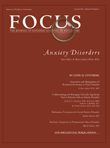Psychotic Symptoms in Posttraumatic Stress Disorder
Abstract
Positive psychotic symptoms may be relatively prevalent in posttraumatic stress disorder (PTSD). PTSD with secondary psychotic features (PTSD-SP) is an emerging diagnostic entity. Phenomenological, epidemiological, and biological studies support the potential validity of PTSD-SP. Clinicians should inquire about positive symptoms of psychosis not only during an initial diagnostic interview but also during follow-up sessions because many patients are embarrassed about these symptoms as well as about other facets and consequences of the traumatic experience and may need some time in a trusting relationship to disclose these symptoms. More studies are needed to investigate, in particular, the longitudinal course and treatment of psychotic features. Genetic studies may shed light on differentiation of PTSD-SP as well as other PTSD comorbidities. The DBH candidate gene in particular may help shed light on this biological differentiation. Treatment of psychotic symptoms associated with PTSD may involve a combination of an antidepressant plus an antipsychotic agent, analogous to the treatment of major depression with psychotic features. The purpose of this article is to introduce the clinician to the potential for psychotic symptoms to occur as a comorbidity of chronic PTSD. This article will review a definition of psychotic symptoms in the context of PTSD and discuss the relevant literature exploring whether the presence of these symptoms might represent a unique subtype of the disorder. The development of a definition for a psychotic subtype of PTSD might facilitate research of treatment approaches. Regardless, the practicing clinician should be aware of the potential for psychotic symptoms to be part of the complex clinical picture of PTSD.



